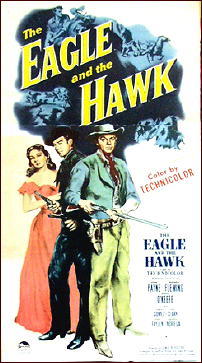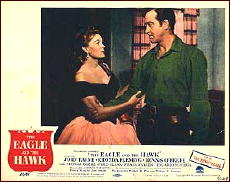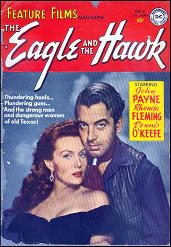Sat 20 Feb 2010
A Movie Review by David L. Vineyard: THE EAGLE AND THE HAWK (1950).
Posted by Steve under Comic Books, Cartoons, Comic Strips , Reviews , Western movies[2] Comments
THE EAGLE AND THE HAWK. Paramount Pictures, 1950. John Payne, Rhonda Fleming, Dennis O’Keefe, Eduardo Noriega, Thomas Gomez, Fred Clark, Frank Faylen, Grandon Rhodes, Walter Reed. Screenplay: Geoffrey Homes & Lewis R. Foster, based on a story by Jeff Arnold. Director: Lewis R. Foster.

The time is 1863, in the midst of the Civil War, and Texas Ranger Todd Croydon (John Payne) is more than a little curious when the man he rescues from the Confederate army at the request of Governor Lubbock (Grandon Rhodes) of Texas proves to be Yankee spy Whitney Randolph (Dennis O’Keefe).
The governor hasn’t turned traitor. O’Keefe is spying on Mexico not Texas. Someone is building an army on the border and O’Keefe has evidence it is part of plot by Napoleon III of France to seize Mexico and wrest it from President Benito Juarez’s fledgling democracy.
Croydon agrees to escort Randolph to Mexico, and once they arrive they learn the plot is more dire than they suspected. Basil Danzeeger (Fred Clark), claiming to be an agent of Juarez, has convinced the charismatic El Captain, the Hawk (Thomas Gomez) to raise and army to invade Texas, vulnerable as the Civil War rages.
What El Captain doesn’t know and must be convinced of is that Danzeeger is really an agent of Napoleon III and Maximillian, so Croydon agrees to spy on Danzeeger while Randolph infiltrates El Captain’s troops.
“Little bit. Worse that can happen to you is you get killed.”

And to complicate things Croydon finds himself falling for Clark’s beautiful wife Madeline (Rhonda Fleming) a French agent who has been smuggling arms into Mexico, and Danzeeger’s right hand man Red Hyatt (Frank Faylen) thinks he remembers Croydon’s face — as he should since Croydon once shot him during a bank robbery.
“Todd.”
“Todd what?”
“Just Todd, my mother was close mouthed.”
Lewis R. Foster and John Payne teamed for several good tough films in this era including El Paso, Crosswinds, and Captain China, and this tough little A western is a good example.
The script, co-written by mystery writer Geoffrey Homes (Daniel Mainwaring) is smart and tough with a dash of international intrigue added to the usual western mix, and Payne and O’Keefe make a good team, the taciturn man of action and the glib fast talking but equally brave secret agent. A running gag about O’Keefe’s uncanny luck at cards and dice and losing his boots actually ties into the plot.
Payne and O’Keefe teamed in at least one other western from the same era, Passage West (1951). Foster is best remembered for writing the original story for Frank Capra’s classic Mr. Smith Goes To Washington, for which he won an Oscar.

The highlights of the film occur when the captured Payne is tied between two wild mustangs, a la Byron’s Mazeppa, to be torn apart as they run wild, and the fiery confrontation on a burning mountain between Danzeeger, Croydon, and El Captain in the finale. James Wong Howe’s legendary touch as the cinematographer is another bonus.
You can download the comic book adaptation of this here under Movie Westerns for free along with a free CBR (comic book reader).
A minor A western with a solid cast and better than usual screenplay, The Eagle and the Hawk will hold your attention, and remind you how many of these solid entertainments Hollywood used to turn out seemingly without effort.
Payne is tough and romantic, O’Keefe cool and slick, Fleming beautiful and passionate, Gomez dangerous but noble, Clark and Faylen treacherous and sadistic — a fairly stock cast, but done with intelligence by sure hands it all adds up to an entertaining oater with a touch of something more, and a tough literate screenplay adds to the film’s bonuses, as does James Wong Howe’s cinematography.
February 21st, 2010 at 6:06 pm
There are several Mazeppa references in Hollywood movies and TV, but this is NOT one of them. Reread Byron! The legend of Mazeppa is a man tied naked, backwards, and helpless on a wild horse. See Heller in Pink Tights or Gypsy for Mazeppa in Hollywood film.
February 21st, 2010 at 8:31 pm
First of all I’ve read Byron thank you, and the Mazeppa reference stands. Mazeppa is a man tied by his enemies to a wild horse to be executed by the running animal in the wilderness. That is all I was referring to.
I honestly do not see all that much difference between being tied to a horse and tied between two horses or tied underneath the horse. The reference is to a man being executed by being tied to a wild horse or horses.
I don’t say here or anywhere that the scene is exactly like Mazeppa — I said ‘a la Mazeppa’, as in the general style of a man being executed by being bound to a wild horse or horses. It is known as an analogy, meaning a reference to something similar, not exact, unless prefaced as in ‘exact analogy’.
The most direct Mazeppa reference is in George Cukor’s offbeat western based on Louis L’Amour’s HELLER IN PINK TIGHTS with Sophia Loren the star of a small acting troop who recreates the Bryron poem on stage in pink tights as the finale of their production.
Although I know Mazeppa was usually played by a woman similarly attired in real 19th century stage productions it is more than a little difficult to imagine Sophia Loren playing a young man even in the most dimly lit theater, especially in pink tights — not that I wouldn’t have wanted to see it.